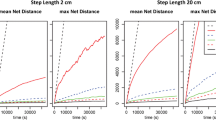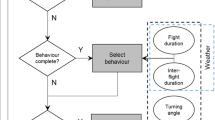Abstract
The Sutton and more recent Gaussian plume models of atmospheric dispersion were used to estimate downwind concentrations of pheromone in a deciduous forest. Wind measurements from two bivane anemometers were recorded every 12 sec and the pheromone was emitted from a point source 1.6 m above ground level at known rates. The wingfanning response of individually caged male gypsy moths (Lymantria dispar) at 15 sites situated 20 to 80 m downwind was used to monitor when pheromone levels were above threshold over a 15-min interval. Predicted concentrations from these Gaussian-type models at locations where wing fanning occurred were often several orders of magnitude below the known behavioral thresholds determined from wind tunnel tests. Probit analyses of dose-response relationships with these models showed no relationship between predicted dose and actual response. The disparity between the predictions of concentration from these models and the actual response patterns of the male gypsy moth in the field was not unexpected. These time-average models predict concentrations for a fixed position over 3-min or longer intervals, based upon the dispersion coefficients. Thus the models estimate pheromone concentrations for time intervals appreciably longer than required for behavioral response.
Similar content being viewed by others
References
Aylor, D.E., Parlange, J.-Y., andGranett, J. 1976. Turbulent dispersion of disparlure in the forest and male gypsy moth response.Environ. Entomol. 5:1026–1032.
Baker, T.C., andRoelofs, W.L. 1981. Initiation and termination of Oriental fruit moth male response to pheromone concentrations in the field.Environ. Entomol. 10:211–218.
Batchelor, G.K. 1952. Diffusion in a field of homogeneous turbulence. II. The relative motion of particles.Proc. Cambr. Phil. Soc. 48:345–362.
Bell, R.A.,Owens, C.D.,Shapiro, M., andTardif, J.R. 1981. Mass rearing and virus production, pp. 599–665,in The Gypsy Moth: Research Towards Integrated Pest Management. USDA Tech. Bull. No. 1584.
Bossert, W.H., andWilson, E.O. 1963. The analysis of olfactory communication among animals.J. Theoret. Biol. 5:443–469.
Cardé, R.T., Doane, C.C., andRoelofs, W.L. 1974. Diel periodicity of male sex pheromone responses and female attractiveness in the gypsy moth (Lepidoptera: Lymantriidae).Can. Entomol. 106:479–484.
Cardé, R.T., Doane, C.C., andFarnum, D.G. 1978. Attractancy to male gypsy moths of (+)-disparlures synthesized by different procedures.Environ. Entomol. 7:815–816.
Cardé, R.T., andHagaman, T.E. 1979. Behavioral responses of the gypsy moth in a wind tunnel to air-borne enantiometers of disparlure.Environ. Entomol. 8:475–484.
Cardé, R.T., andHagaman, T.E. 1983. Influence of ambient and thoracic temperatures upon sexual behaviour of the gypsy moth,Lymantria dispar Physiol.Entomol. 8:7–14.
David, C.T., Kennedy, J.S., Ludlow, A.R., Perry, J.N., andWall, C. 1982. A re-appraisal of insect flight towards a distant, point source of wind-borne odor.J. Chem. Ecol. 9:1207–1215.
Elkinton, J.S., andCardé, R.T. 1984. Odor dispersion.In Chemical Ecology of Insects. Chapman and Hall, London.
Fares, Y., Sharpe, P.J.H., andMagnuson, C.E. 1980. Pheromone dispersion in forests.J. Theoret. Biol. 84:335–359.
Finney, D.J. 1971. Probit Analysis, 3rd ed. Cambridge University Press, London.
Gifford, F. A., Jr. 1968. An outline of theories of diffusion in the lower layers of the atmosphere, pp. 65–116,in D.H. Slade (ed.) Meteorology and Atomic Energy. U.S. Atomic Energy Commission, Oak Ridge, Tenn.
Hagaman, T.E., andCardé, R.T. 1984. Effect of pheromone concentration on the organization of pre-flight behaviors of the male gypsy moth,Lymantria dispar (L.).J. Chem. Ecol. (10:17–23).
Mason, C.J. 1973. Meteorological dispersion models and their applications to aerobiological problems. Presented at Workshop/Conference III, “Ecological Systems Approaches to Aerobiology,” US/IBP Aerobiology Program, University of Michigan, Ann Arbor.
Miksad, R.W., andKittredge, J. 1979. Pheromone aerial dispersion: A filament model. 14thConf. Agr. Forest Meteorol. Am. Meteorol. Soc., pp. 238–243.
Murlis, J., andJones, C.D. 1981. Fíne-sćale structure of odour plumes in relation to insect orientation to distant pheromone and other attractant sources.Physiol. Entomol. 6:71–86.
Nakamura, K. 1976. The effect of wind velocity on the diffusion ofSpodoptera litura (F.) sex pheromone.Appl. Entomol. Zool. 11:312–319.
Pasquill, F. 1961. The estimation of the dispersion of wind-borne material.Met. Mag. 90:33–49.
Pasquill, F. 1974. Atmospheric Diffusion. Halsted Press-John Wiley, New York.
Roelofs, W.L. 1978. The threshold hypothesis for pheromone perception.J. Chem. Ecol. 4:685–699.
Shapas, T.J., andBurkholder, W.E. 1978. Patterns of sex pheromone release from adult females, and effects of air velocity and pheromone release rates on theoretical communication distances inTrogoderma glabrum.J. Chem. Ecol. 4:395–408.
Slade, D.H. (ed.). 1968 Meteorology and Atomic Energy. U.S. Atomic Energy Commission, Oak Ridge, Tenn.
Sutton, O.G. 1947. The problem of diffusion in the lower atmosphere.Q. J. Roy. Meteorol. Soc. 73:257–281.
Sutton, O.G. 1953. Micrometeorology. McGraw-Hill, New York, 333 pp.
Wright, R.H. 1958. The olfactory guidance of flying insects.Can. Entomol. 90:81–89.
Author information
Authors and Affiliations
Additional information
Michigan Agricultural Experiment Station Journal Article No. 10914.
Rights and permissions
About this article
Cite this article
Elkinton, J.S., Cardé, R.T. & Mason, C.J. Evaluation of time-average dispersion models for estimating pheromone concentration in a deciduous forest. J Chem Ecol 10, 1081–1108 (1984). https://doi.org/10.1007/BF00987515
Received:
Revised:
Issue Date:
DOI: https://doi.org/10.1007/BF00987515




